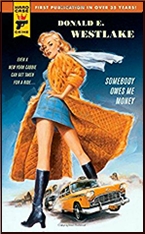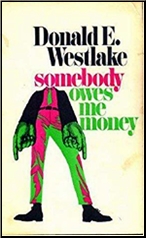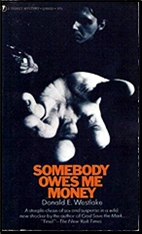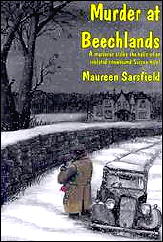Sat 16 Jun 2018
Mystery Review: DONALD E. WESTLAKE – Somebody Owes Me Money.
Posted by Steve under Reviews[8] Comments

DONALD E. WESTLAKE – Somebody Owes Me Money. Hard Case Crime , softcover, June 2008. First published by Random House, hardcover, 1969; and Signet Q4800, paperback, 1971.
It is difficult to realize that this comedy romp from one of the grand masters of comedy romp mysteries will have its 50th anniversary next year. The funny thing is that there’s almost nothing dated about it. Except for some technological advances such as iPhones that are missing, this wacky caper could have taken place yesterday, and what’s more there’s nothing in this plot that would have gone another way even if anyone did have an iPhone.

Not that the plot is all that complicated, either. A cabbie named Chet Conway is given a tip on a horse that pays off at 27-to-1, but when he stops by his bookie’s apartment to get his money, he finds the bookie shot to death. Question: who’s going to pay him his $900?
Major problem: his bookie was playing both sides of two rival crime gangs, and they both think Chet did it. Forget the money. Can Chet get out of the scrape he’s in alive? Aiding him is Abbie, the bookie’s sister, illustrated superbly on the book’s cover. (See above.) Not only is she luscious to look at, but she’s also a card sharp from Las Vegas.

Minor problem, at least as far the story is concerned, is that the warfare between the two gangs, not all of whom are all that bright, which is where the comic element comes in, goes on a few pages too long. And of course after exhausting all of the plot possibilities so far suggested — and most of the participants — everyone eventually comes to realize that neither gang is responsible for the killing.
This is a good thing, as it allows the tale to perk up again with a “gather all the suspects together” kind of ending which polishes off all the loose ends most satisfactorily.
There are lots of copies of the Hard Case Crime edition around, so the book is not hard to find. Even though it’s almost 50 years old, you have no excuse for letting this one slip by.
